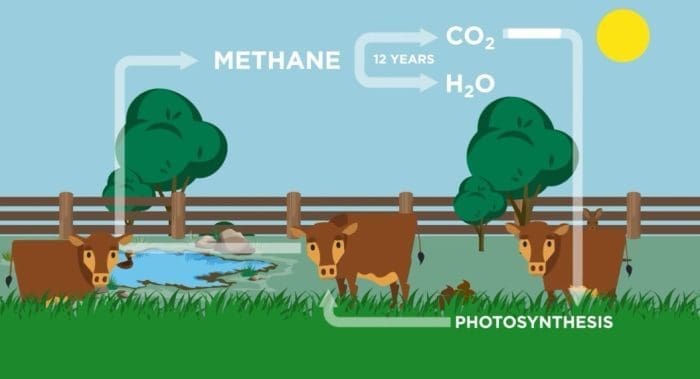AS the environmental impact of livestock-related methane emissions becomes a hot topic in the global climate change debate, calls are growing for wider recognition of more relevant ways to represent the industry’s footprint.
Livestock have been front and centre in climate politics in recent weeks, as the Federal Government looks to sign onto the Global Methane Pledge and other countries, including New Zealand, put restrictive legislation on livestock producers.
While many countries are moving on livestock emissions and the industry is putting in its own measures, like the carbon neutral by 2030 target, the way livestock emissions are accounted for is still creating some concern among the science community.
The current metric used to represent emissions across most industries is called GWP 100 (Global Warming Potential), which aims to put all gases on a common scale of “CO2 equivalence” over a 100-year time horizon.
But CSIRO principal research scientist, Agriculture and Food, Dr Brad Ridoutt said GWP 100 was not the only way of aggregating emissions and may not necessarily be the most relevant way for the livestock industry to report emissions and direct climate action.
“Methane emissions have a relatively short-term impact on the climate, unlike CO2 and other longer-lived greenhouse gases (GHG),” he said.
Dr Ridoutt said the main scientific body, the Intergovernmental Panel on Climate Change (IPCC), had made the distinction between the different gases.
He pointed to this quote “Stabilizing the climate will require strong, rapid, and sustained reductions in greenhouse gas emissions, and reaching net zero CO2 emissions. Limiting other greenhouse gases and air pollutants, especially methane, could have benefits both for health and the climate.”
Several other metrics have been developed to better represent livestock emissions – the most well-known one is an Oxford University method called GWP star. Dr Ridoutt has also been part of the development of a methodology called the radiative forcing footprint (RF).
“With GWP star, it looks at whether methane emissions are increasing or decreasing over time.
“However, livestock emissions can jump up and down like a yoyo, with seasonal conditions and herds expanding and contracting,” he said.
“This creates some issues with GWP star because it can be hard to discern a steady rate of change.
“The radiative forcing footprint has some similarities with GWP star but is simpler,” Dr Ridoutt said.
“GHG emissions contribute to global warming by increasing radiative forcing.
“The RF footprint aggregates RF from current emissions with the residual RF from historical emissions,” he said.
“This way, we see whether the industry is increasing its overall footprint or decreasing it.
“When RF is stabilized, the industry might be considered ‘climate neutral’, i.e., no longer adding to further climate change. This is what the Paris Agreement is all about, stabilizing the climate,” Dr Ridoutt said
“This is what I have shown with the sheep meat industry, this industry is no longer adding to additional climate change.”
How the livestock industry’s emissions are reported
All sectors, including livestock, have their emissions reported annually in a Federal Government document called the National Greenhouse Gas Inventory. MLA releases its own GHG footprint, which includes similar information to the NGGI.
Dr Ridoutt suggests the red meat industry take on the use of a metric like the RF footprint.
“They should be using the metric that is relevant to them and taking a proactive approach, because it gives better information in regard to the goal of climate stabilisation.
“The industry can voluntarily report whatever it wants, provided it is science based and factual.”
In response, MLA CN30 manager Dr Margaret Jewell said investment was currently underway, via Dr Ridoutt, to enable the use of such metrics, with results expected towards the end of this year.
“In Australia we’re aiming to use all of the metrics we can, because we think it is important to report really transparently about the impact of livestock on the climate.
“It is also important so we can set appropriate policy and mitigations,” Dr Jewell said.
Shift away from GWP 100
Dr Ridoutt said the universal use of GWP 100 was not warranted. The results can be difficult to interpret when there are substantial short-term emissions like methane.
“We need to look at what we are trying to achieve and under the Paris Agreement, it is about keeping the global average temperature below a 2-degree increase – ambitiously 1.5 degrees.
“All through the IPCC reports they don’t prescribe any metric and they caution against the use of any particular metric, because it might not answer the question at hand,” he said.
Dr Ridoutt said reducing methane was important because it can create scope for the industry to grow without increasing its RF footprint.
Along Dr Ridoutt, several respected scientists, including University of California Davis professor Frank Mitloehner and Oxford University professor Myles Allen, have been pushing for more transparent measurement of livestock emissions for years.
Prof Allen told a recent inquiry, held by the Irish Government, that it could be leading the world by including metrics, like GWP star, in its greenhouse gas account, alongside GWP100 measurement.
“We can fix the problem of not reporting warming impact tomorrow and you can calculate it on a farm-by-farm level,” he said.
“If you were to do this, it would be interesting for Irish farmers because they would discover the things they can do to reduce global temperatures.
“This issue with reporting is not a problem we need to have.”
Industry aims for carbon neutral
While red meat industry is pushing ahead on its plans to become carbon neutral by 2030, MLA managing director Jason Strong said the development of metrics like RF and GWP star was important to the industry.
“Climate neutrality is one of those little bonuses on the way to carbon neutral – it is really important because so many of the global commitments, like the Paris agreement, are based on warming.
“Methodologies like RF and GWP star are very important, there is plenty of people focusing on them and we will certainly stay across them” Mr Strong said.
“But the CN30 target is one that we will keep putting our efforts into and making sure we have the tools and suite of solutions to allow people to do that.
“We want to be in a position where we can maintain a larger herd and flock in a sustainable way.”
Government not adopting other methodologies
Beef Central contacted minister for energy and climate change Chris Bowen and asked if the government was considering putting additional information on livestock emissions in the NGGI – using metrics like RF and GWP star. A spokesperson for the minister said it was not in the plans.
“Australia is required to use the GWP-100 metric for reporting under the Paris Agreement. The GWP star method is not currently recognised in international inventory reporting rules,” he said.



HAVE YOUR SAY